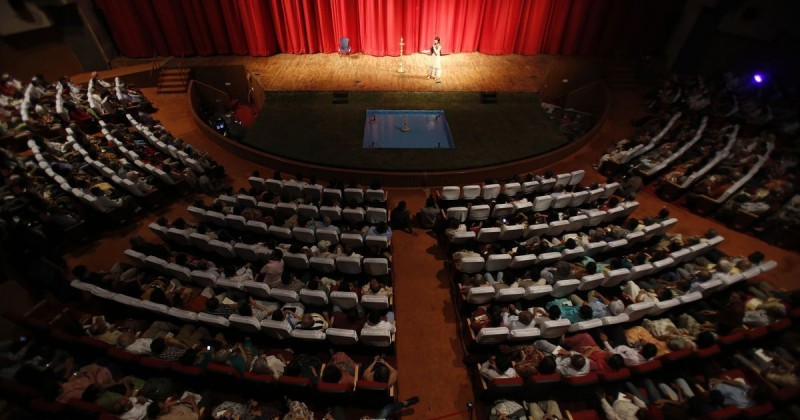
The rich and vibrant history of Indian theater traces back to ancient times, woven into the cultural fabric of the nation. Over the centuries, Indian theater has evolved, assimilating various influences, and producing a diverse array of performances. This article delves into the captivating journey of Indian theater, from its ancient origins to its contemporary significance.
The introduction of theater in India can be attributed to its thriving oral traditions, where stories were narrated and depicted through various folk performances. These traditional forms laid the foundation for the emergence of more structured theatrical presentations.
2. Ancient Origins of Indian Theater
2.1 Folk Performances
Indian theater's roots can be found in the age-old folk performances, such as Nautanki, Ram Leela, and Yakshagana. These colorful and musical performances brought myths, legends, and epics to life, captivating audiences across the country.
2.2 Sanskrit Drama
The development of Sanskrit drama marked a significant milestone in Indian theater. Ancient playwrights like Kalidasa created masterpieces like "Abhijnanasakuntalam" and "Shakuntala," showcasing the sophistication of theatrical artistry in ancient India.
3. Evolution of Indian Theater
3.1 Medieval Theater
During the medieval period, Indian theater witnessed a fusion of indigenous styles with the influence of Islamic culture. The Sufi mystics integrated theatrical elements into their performances, resulting in the birth of Sufiana Mausiqi and Sufi Qawwalis.
3.2 Influence of Islamic Culture
The Mughal era brought further changes to Indian theater, with the introduction of dance and music-rich dramas like "Ras Leela" and "Raas Dhar." These performances became an integral part of cultural celebrations.
3.3 Colonial Era Theater
The British colonization impacted Indian theater significantly. Western theatrical conventions began to influence Indian performances, leading to the formation of Parsi Theater, which was a blend of Indian and European dramatic styles.
4. The Renaissance of Indian Theater
4.1 Influence of Western Theater
The 20th century witnessed a renaissance in Indian theater as Indian artists started embracing and experimenting with Western theatrical techniques. This period saw the emergence of legendary playwrights like Rabindranath Tagore and Vijay Tendulkar.
4.2 Bengal Theater Movement
The Bengal Theater Movement played a pivotal role in revitalizing Indian theater. Notable figures like Sisir Kumar Bhaduri and Badal Sircar contributed to the growth of experimental theater and socially relevant plays.
4.3 Prithvi Theatre and its Impact
Prithviraj Kapoor's Prithvi Theatre became a driving force behind the promotion of Indian theater. It provided a platform for budding artists and staged iconic productions, contributing to the popularity of theater across India.
5. Contemporary Indian Theater
5.1 Regional Theater Traditions
India's diverse cultural landscape is reflected in its regional theater traditions. Each region boasts its unique styles, incorporating local themes, languages, and performing arts.
5.2 Bollywood and Theater
Bollywood's dominance in the entertainment industry has impacted Indian theater. Many theater artists have seamlessly transitioned to Bollywood, contributing to the blurring lines between the two forms of storytelling.
5.3 Experimental and Alternative Theater
Contemporary Indian theater continues to embrace experimentation and alternative approaches. Theater groups and artists often explore unconventional themes, pushing boundaries, and challenging societal norms.
6. Challenges Faced by Indian Theater
6.1 Commercialization and Popularity of Movies
The popularity of movies and digital entertainment has posed challenges for traditional theater. Ensuring theater's survival amid the allure of mass media remains a critical concern.
6.2 Funding and Infrastructure
Limited funding and inadequate infrastructure have hampered the growth of Indian theater. Many talented artists struggle to find support and resources for their creative endeavors.
6.3 Preservation of Traditional Forms
Preserving traditional theater forms and passing them on to the next generation is essential to maintain India's cultural heritage. Modernization should not lead to the neglect of these invaluable art forms.
7. The Influence of Indian Theater on the Global Stage
7.1 Recognition and Appreciation
Indian theater has earned global recognition for its artistic brilliance and cultural significance. Various Indian productions have received accolades at international theater festivals.
7.2 Indian Theater Artists Abroad
Indian theater artists have made a mark on the global stage, with many achieving success and acclaim in foreign productions. Their talent and dedication have contributed to cross-cultural collaborations.
7.3 Cultural Exchange and Collaborations
Indian theater's journey includes numerous collaborations with international artists and theater groups. These exchanges have enriched the theatrical experience and fostered cultural understanding. Indian theater's journey is a tapestry of artistic brilliance, cultural diversity, and resilience. From its humble beginnings in folk performances to its contemporary form, Indian theater continues to captivate audiences with its storytelling prowess. While facing challenges, it remains a vital medium for artistic expression and cultural preservation. With the spirit of innovation and the support of theater enthusiasts, the vibrant journey of Indian theater is destined to endure and flourish.
Jio to Lift up at whopping Profits amid 5G Adoption in First Half this Year